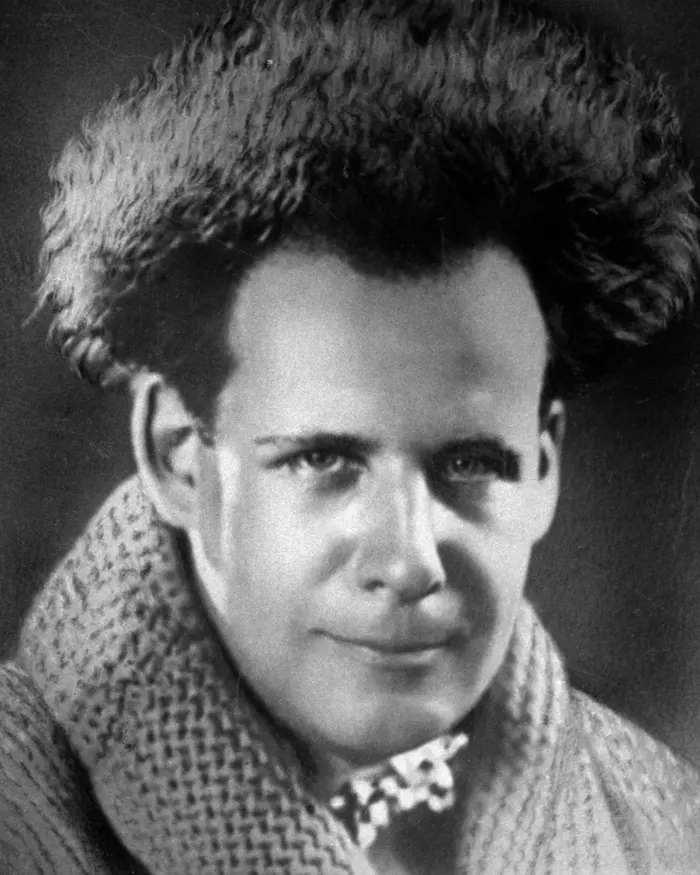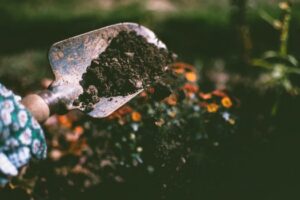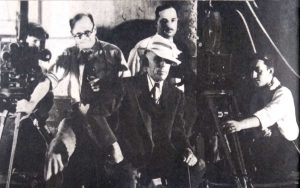 Pin
Pin D.W. Griffith, in the hat, directing one of his silent films. ‘Talkies’ led to his decline and he died in poverty.
It was an unlikely place for a revolution. Down in the basement of a café in Paris, two French brothers, Louis and Auguste Lumière, presented a short film to a select audience. It showed workers leaving the brothers’ factory for their dinner hour and it was the first film to be presented publicly on a screen. The date was 1895 and it is a nice coincidence that Lumière is the French for light.
The Lumières did not ‘invent’ the motion picture. As with so many other great inventions, a number of people in a number of countries were at work separately on the project. Among them were the American, Thomas Edison, and the Britons, William Friese-Greene and Robert Paul. Edison’s contribution was the kinetoscope, designed either by himself or his assistant, William Dickson. It was a box in which just over 15 metres of film revolved on spools. There was a peephole in the box for a viewer.
Though the kinetoscope had some success in America and Europe, Edison did not believe it had a future, so it was left to others to improve it. The Lumières used a Cinematograph, which means moving picture, and which was a combined camera and projector. Their films lasted 45 seconds, and soon they had made the first story film, Watering the Gardener!
Edison and others now saw a future in films, and by 1900 films were being shown as extra attractions in music halls and fun fairs. However, once people had got over their surprise — some expected to be soaked by a sea scene — the novelty began to wear off. It had helped that there was no language problem, films being silent, and that everyone was soon using 35mm film, but a new revolution was needed.
It came with the arrival of the story film, something more ambitious than a few seconds of the Lumière’s gardener being drenched. By 1901, a brilliant French magician, Georges Méliès, had — made an ever-growing number of short science fiction and fairy tale films, directing them as well as writing and acting in them.
But it was the American, Edwin S. Porter, who was the first to make movies for the millions. Not only did he make the first Western, The Great Train Robbery in 1903, which lasted 11 minutes, but he pioneered modern techniques.
He saw that it was common sense to shoot films out of sequence. He would shoot every scene that occurred in one setting, then every one that occurred in another, and finally he would edit the separate shots into a clear story. He added to the excitement by switching the action from the escaping train robbers to the forming of the posse, tricks of the trade which are still used.
The film made a fortune, packing every hall where it was shown. More films were rushed into production and ‘‘nickelodeons’’ were built to house them. These were the first cinemas. Five cents, or a nickel, was the entrance fee, for which the patron saw a number of films, with a pianist playing suitable music.
The silent cinema as a mass attraction had been born.
Hollywood, destined to be the world’s film capital, was born soon after. The climate and variety of scenery appealed to film-makers who had been shooting their films in the eastern U.S.A.
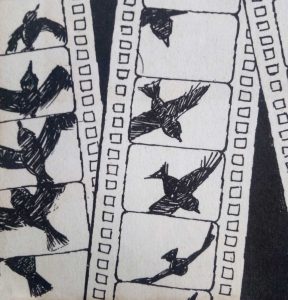 Pin
Pin A Cinema film consists of separate pictures showing different movements of the subject concerned.
By presenting to the eye a rapid sequence of pictures, each showing one stage of movement, an impression of movement is obtained. The revolving discs on the right shows an early adaptation of this idea.
The World’s Sweetheart
Here, too was born the star system when an unknown girl named Florence Lawrence was renamed Mary Pickford and became ‘‘the World’s Sweetheart’’ as well as the first star to earn a million dollars. She was also a good actress, unlike some silent stars who over-acted abominably.
America’s biggest break came in 1914 when Europe’s film-making was virtually halted by World War One. Shortly before this, D. W. Griffith, the first great director, had started work. The director is the key figure in filming because he shapes every shot and scene and decides how actors shall interpret their roles.
Griffith made filming an art. He was the first to move the camera about and, though he did not invent close-ups, he showed how important they were. He took a number of shots of the same scene so as to vary close-ups with longer shots and he was an editor of genius.
One result was the first epic film, The Birth of a Nation, which was set in and after the American Civil War and remains a masterpiece to this day.
Yet it is for comedy that the silent cinema is best remembered. True, legendary names like the athletic Douglas Fairbanks Senior, William S. Hart, the Western star, and Rudolph Valentino, the “Great Lover’’, have not been forgotten.
But Charlie Chaplin, Buster Keaton, the Keystone Kops, Laurel and Hardy and other silent stars — some of whom later ‘‘talked’’ — still delight countless millions all over the world.
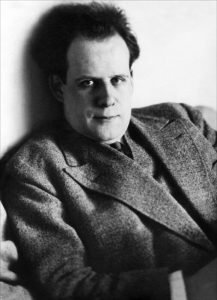 Pin
Pin S. M. Eisenstein received the Order of Lenin in 1938 for “Alexander Nevsky”, the first of a planned film trilogy. The second, “Ivan the Terrible” was shot in 1944 and 1946.
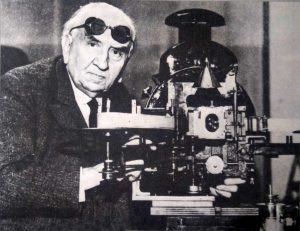 Pin
Pin Louis Lumière, aged 71, in 1935 with his then new stereoscopic film apparatus. The special tinted spectacles helped his illusion.
The master of many of the revels was Mack Sennett, whose Keystone Studios opened in 1912. Of course, some of his most amazing effects were done by trick photography, but stars like Keaton and Harold Lloyd pulled off many daring and amazing stunts themselves.
American films cheered a war-torn world, and after the war the cinema boomed. Vast studios opened in Hollywood which became big business. With the war over, other nations returned to making movies, most notably the Germans, who made giant strides in the use of the camera. And Soviet Russia produced a genius in Sergei Eisenstein, whose Battleship Potemkin, about a mutiny in the old Russian navy, caused a worldwide sensation.
As those who have seen silent films will know, “titles’’ were inserted into films where they were needed to help tell the story and also some dialogue. Naturally, when the films were shown in non-English speaking areas, translators got to work.
Cinemas became more and more grand, while little cinemas mushroomed everywhere. The money involved was colossal, and so were the profits. Actors whose voices were not so good, but who looked right, could make fortunes in silent movies.
Suddenly, almost overnight, sound came to the cinema. This tremendous revolution will get a feature to itself, but a single statistic will show just what a revolution it was. In 1927, the year the very first sound film appeared, some 60 million Americans went to the movies. Only two years later, with silent films dead beyond recall, attendance figures reached 110 million.
The Projectionist
Nowadays, projecting — that is, showing films — is almost wholly automatic and the projectionist is little more than a machine-minder. This was by no means the case in the early days. When films were first shown, usually in halls normally used for other purposes, film projection was an art. The projector had to be operated by hand (see below), and the action of the film could be slowed down or speeded up, depending on how fast the projectionist turned the handle of the projector. Many of the early films used trick effects to startle or amuse their audiences, and the success on the skill of the projectionist.
 Pin
Pin 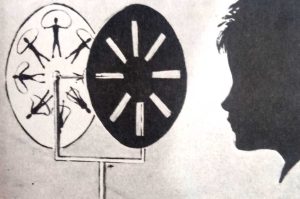 Pin
Pin It is possible to make a sort of ‘film’ by drawing pictures of the different stages of a figure’s movement on the pages of a book. By flicking the pages, the figure seems to move. Edison’s very early ‘optical phonograph’, shown below, used photographs, not drawings. This projected the pictures by means of a rotating cylinder.
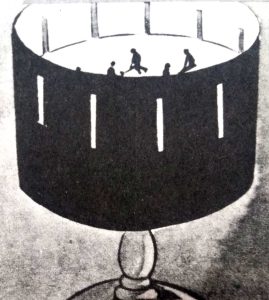 Pin
Pin The cinema, also known as film or motion picture, originated in the late 19th century. The development of cinema can be traced back to various technological advancements and innovations during that time.
-
01
The invention of the motion-picture camera
In the late 19th century, inventors such as Thomas Edison in the United States and the Lumière brothers in France developed motion-picture cameras capable of capturing moving images and recording them onto film.
-
02
The creation of film projection systems
Alongside the development of the motion-picture camera, inventors also worked on creating devices capable of projecting these recorded moving images onto a screen. The Lumière brothers’ Cinématographe, patented in 1895, was one such invention that combined a camera, film processing unit, and projector.
CopiedThe creation of film projection systemsAlongside the development of the motion-picture camera, inventors also worked on creating devices capable of projecting these recorded moving images onto a screen. The Lumière brothers' Cinématographe, patented in 1895, was one such invention that combined a camera, film processing unit, and projector.
-
03
Early forms of cinema
In the late 19th and early 20th centuries, the earliest forms of cinema emerged, featuring short, silent films. These films were shown in dedicated venues known as “nickelodeons” or small theaters. They usually consisted of simple narratives or scenes showcasing everyday activities.
CopiedEarly forms of cinemaIn the late 19th and early 20th centuries, the earliest forms of cinema emerged, featuring short, silent films. These films were shown in dedicated venues known as "nickelodeons" or small theaters. They usually consisted of simple narratives or scenes showcasing everyday activities.
-
04
Advancements in filmmaking techniques
As the cinema industry gained momentum, filmmakers experimented with techniques that enhanced storytelling. The use of editing, special effects, and narrative structures evolved, leading to longer and more complex films.
-
05
Sound in cinema
The introduction of synchronized sound in the late 1920s revolutionized the cinema industry. With the release of “The Jazz Singer” in 1927, which featured synchronized dialogue and music, silent films gradually gave way to sound films.
-
06
Technological advancements and genres
The cinema industry continued to evolve with advancements such as color films, widescreen formats, and special effects. Different genres such as comedy, drama, romance, and action emerged, catering to diverse audience preferences.
There were several key pioneers and innovators in the early days of cinema who made significant contributions to its inception and growth. Some of them include:
-
Thomas Edison
Edison is often credited with inventing the motion picture camera, known as the Kinetograph. He also developed the Kinetoscope, a device used for viewing moving pictures. Edison’s inventions laid the foundation for the development of the film industry.
-
Lumière Brothers
Auguste and Louis Lumière, known as the Lumière Brothers, were among the first to exhibit projected motion pictures to a paying audience. They invented the Cinematograph, a combination of a camera, printer, and projector, which enabled the shooting, developing, and screening of films. Their first public screening in 1895 marked the beginning of cinema as a popular entertainment medium.
-
Georges Méliès
Méliès was a French filmmaker and illusionist who is often referred to as the “Father of Special Effects.” He pioneered various techniques such as stop-motion animation, double exposure, and time-lapse photography. Méliès’ films, including the iconic “A Trip to the Moon” (1902), showcased innovative storytelling and visual effects.
-
D.W. Griffith
Griffith is considered a pioneer of narrative filmmaking and the creator of modern film grammar. His film “The Birth of a Nation” (1915) revolutionized cinematic storytelling with its complex narrative structure, use of close-ups, and innovative editing techniques. Griffith’s work set the standard for Hollywood filmmaking for years to come.
-
Sergei Eisenstein
Eisenstein was a Soviet filmmaker and theorist who made significant contributions to the development of film editing and montage. He believed that editing could create a powerful emotional impact on the audience. Eisenstein’s famous films such as “Battleship Potemkin” (1925) showcased his innovative and influential use of montage, which inspired generations of filmmakers.
These pioneers and innovators played a crucial role in the early days of cinema, establishing the foundations of film technology, storytelling techniques, and visual effects. Their contributions laid the groundwork for the growth and evolution of the cinema industry as we know it today.
Early filmmakers experimented with storytelling techniques in several ways during the early days of cinema:
- 1. Narrative Structure: Filmmakers started exploring and experimenting with different ways of structuring their films. They began by adapting the existing techniques of theater and literature, such as plays and novels. They used techniques like linear storytelling, where events unfold in a chronological order, to establish a clear narrative structure.
- 2. Editing: In the early days, filmmakers started discovering the power of editing. They experimented with different ways of arranging shots to create meaning and convey emotions. They combined shots from different locations, scenes, and time periods to tell a cohesive story. Filmmakers like Georges Méliès used editing techniques to create illusion and fantasy in his films.
- 3. Montage: Filmmakers like Sergei Eisenstein experimented with the concept of montage, in which shots are juxtaposed to create meaning that goes beyond individual shots. Eisenstein used montage to manipulate time, space, and emotion, creating powerful and impactful scenes in his films.
- 4. Camera Techniques: Early filmmakers also experimented with various camera techniques to enhance storytelling. They explored the use of camera movements, such as pans, tilts, and tracking shots, to create a dynamic visual experience. Filmmakers like D.W. Griffith developed the concept of close-ups and long shots, using them to convey intimate emotions or establish a sense of scale and context.
- 5. Special Effects: Early filmmakers heavily relied on practical effects and in-camera tricks to enhance their storytelling. Techniques like stop-motion animation, superimposition, and double exposure were used to create moments of magic, transformation, or otherworldliness in their films. Films like “A Trip to the Moon” by Georges Méliès showcased early experimentation with special effects.
- 6. Sound and Music: While initially films were silent, early filmmakers started exploring the potential of incorporating sound and music to enhance storytelling. They experimented with live music accompaniment, sound effects, and even synchronized sound in some cases to enrich the cinematic experience.
Early filmmakers were curious and inventive, constantly pushing the boundaries of storytelling techniques available at the time to create new and engaging ways to convey narratives through the medium of cinema.
The earliest forms of public exhibition of cinema were primarily in the form of short films shown in fairgrounds, vaudeville theaters, and music halls. These films were usually brief, lasting only a few minutes, and were often shown as part of a larger variety program.
One of the pioneering figures in the public exhibition of cinema was the Lumière brothers, who held the first public screening of their short films in December 1895 in Paris. They used their invention, the Cinématographe, to project moving images onto a screen. This event, known as the Lumière brothers’ first public screening, marked the beginning of cinema as a popular form of entertainment.
Initially, audiences were astounded and fascinated by this new form of entertainment. They were captivated by the moving images, which seemed incredibly lifelike and magical to them. Many were even afraid and confused, thinking that the train depicted in one of the Lumière brothers’ films was going to crash into the theater. This early response shows the novelty and impact that cinema had on the audience.
The popularity of these early film exhibitions rapidly grew, with people flocking to theaters and fairgrounds to witness this new form of entertainment. Films depicting everyday activities, such as workers leaving a factory or a train arriving at a station, drew large crowds. As the medium progressed, filmmakers started to experiment with storytelling, adding narratives, and developing longer films.
The earliest forms of public exhibition of cinema received a highly positive response from audiences. It quickly captured people’s imagination and became a significant part of popular culture.
Frequently Asked Questions: The Cinema commencement
While cinema’s invention was a collaborative effort involving numerous pioneers, two key figures are often credited with its development. The Lumière brothers, Louis and Auguste, from France, are widely recognized for their groundbreaking work in creating the first public film screening in 1895. Their invention, the cinematograph, allowed for the capturing, processing, and projection of moving images.
Several significant inventions played crucial roles in the development of early cinema. The invention of photography in the early 19th century, particularly the Daguerreotype by Louis Daguerre and the calotype process by Henry Fox Talbot, laid the foundation for capturing still images. Additionally, the Zoetrope, a pre-cinema animation device, and the concept of persistence of vision, which suggests that the human eye retains images for a brief moment after viewing, were influential in conceptualizing motion pictures.
The first public film screening took place on December 28, 1895, at the Salon Indien du Grand Café in Paris. The Lumière brothers showcased ten short films, including scenes of everyday life, such as workers leaving a factory and a train arriving at a station. This event marked a significant milestone in the history of cinema as it introduced the concept of projected moving pictures to a wide audience.
The Lumière brothers’ cinematograph quickly gained popularity, leading to the emergence of numerous filmmakers and studios worldwide. Filmmakers began experimenting with longer narratives and creative storytelling techniques. In 1902, Georges Méliès, a French illusionist and filmmaker, produced “Le Voyage dans la Lune” (A Trip to the Moon), one of the first science fiction films, showcasing pioneering use of special effects.
Silent films, without synchronized sound, were the norm until the late 1920s. In 1927, Al Jolson’s “The Jazz Singer” became the first widely successful film to feature synchronized sound, marking the beginning of the “talkies” era. This breakthrough led to fast-paced technological advancements in sound recording and reproduction systems.
Color films also gradually developed alongside silent films. The earliest attempts at color film involved hand-painting each frame, but this process was time-consuming and expensive. Technological advancements, such as the introduction of the three-strip Technicolor process in the 1930s, made color films more accessible and visually appealing.
Cinema has continuously evolved since its early days. The development of new film formats, from 16mm to 35mm and eventually digital formats, revolutionized film production and distribution. New genres, such as westerns, film noir, and sci-fi, emerged, reflecting societal changes and capturing the imagination of audiences.
With the advent of home video technology, the cinema experience expanded beyond movie theaters, allowing people to watch films in the comfort of their homes. Today, the rise of streaming platforms and digital distribution has further transformed the landscape of cinema, offering viewers unlimited access to an extensive library of films from various countries and eras.
The commencement of cinema can be attributed to a confluence of technological advancements, creative minds, and entrepreneurial spirit. From humble beginnings as a novelty entertainment medium, cinema has evolved into a globally celebrated art form and a significant cultural influence.



















